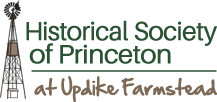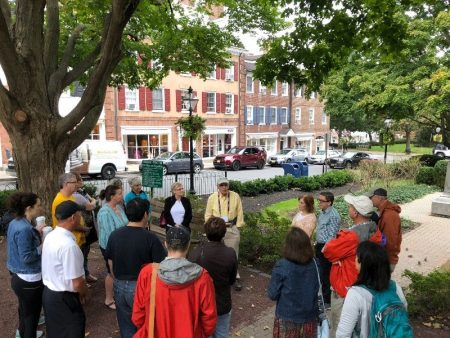Let us bring history to you! HSP offers outreach programs to support your classroom curriculum.
All outreach programs are available to present virtually.
All programs align with NJ Department of Education 2020 New Jersey Student Learning Standards – Social Studies. All programs address Standard Number 6.1: US History. Specific standards codes for each program are available upon request. The programs focus on performance expectations that include:
- Civic and Political Institutions (PI)
- Economic Ways of Thinking (ET)
- Exchanges and Markets (EM)
- Continuity and Change (CC)
- Understanding Perspectives (UP)
- Historical Sourcing and Evidence (SE)
Some programs are available for younger or older grade levels beyond those specified. Please contact us to discuss a customized program.
Jump to: Elementary/Middle School Programs
Jump to: High School Programs
Elementary/Middle School Programs
Powerpoint presentations are conducted in a discussion format, with a lively interaction between HSP’s Director of Programs and your students.
Princeton: Then and Now
Grades: K-8
Length: 1 hour
Cost: $125 per program
NJCCC standards: 6.1; 6.2
The town of Princeton was settled more than 300 years ago. What has changed over the years, and what has stayed the same? Tour the town from the comfort of your classroom and compare images of transportation, shopping, education and historic sites. At the conclusion of the presentation, students will design postcards of their town 100 years in the future.
The Life of Albert Einstein
Grades: 4-8
Length: 1 hour
Cost: $125 per program
NJCCC standards: 5.1; 5.2; 6.1; 6.2
Through this interactive presentation, students will examine the life of the man whose name has become synonymous with “genius.” Learn how a childhood fascination with a compass played a role in the development of the Nobel prize-winning scientist, how he accepted a job in Princeton to escape Nazi Germany and how he used his celebrity to advocate for civil rights and advance world peace.
New Jersey Facts and Firsts
Grades 3-8
Length: 60 minutes
Cost: $125 per program
NJCCC standards: 6.1, 6.2
Celebrate the history of the Garden State! Using themes of innovation, diversity and liberty, this program highlights the Lenape Indians and early European settlers, the development of cities and suburbs, as well as technology and inventions. This fun and interactive presentation includes a multiple choice game to identify N.J. facts, symbols and local celebrities. A great connection to your classroom curriculum!
High School Programs
Students deeply engage with primary sources in a seminar-style workshop, where programs are structured around guided student inquiry.
Palmer Square: A Primary Source Discovery Program
Grades 9-12
Length: 90 minutes
Cost: $125
Maximum capacity: 30 students
NJCCC standards: 6.1.12; N.J.S.A. 18A 52:16A-88 (Amistad Law)
Guided by Historical Society of Princeton educators, students will use primary sources, including maps, architectural plans, letters, oral histories, and directories, to discover the story of Palmer Square, and the impact of urban renewal on Princeton’s African-American community and town landscape. This program emphasizes critical thinking skills with regard to analyzing primary sources and promotes student agency in asking key historical questions. The stories revealed during the program provide a snapshot into the history of racism and segregation in Princeton.
Document-Based Introduction to the History of Racism in Princeton
Grades 9-12
Length: 90 minutes
Cost: $125
Maximum capacity: 30 students
NJCCC standards: 6.1.12; N.J.S.A. 18A 52:16A-88 (Amistad Law)
This program offers a conversational exploration of ten historical documents from Princeton. Students examine each document, reading it closely, getting to know its historical context, and understanding how it illuminates the history of racism in America, as it played out in Princeton. Documents touch on histories of slavery, discrimination, school and housing segregation, and resistance. This is a guided investigation of the archival remains of Princeton’s past, shining a light on the historical research process as well as how and what stories are preserved.

